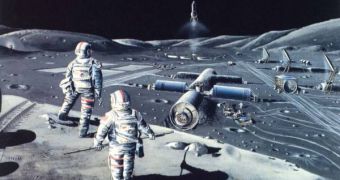Experts at the National Aeronautics and Space Administration (NASA) and the US Department of Energy (DOE) are currently investigating technologies that could allow for the construction of a fission reactor on the Moon in the future, to help power potential outposts that may be established. The new system is reportedly scheduled to be completed by 2020, and has to be safe, reliable and efficient, Technology Review informs. By the end of the next decade, the space agency plans to reestablish an American lunar presence, with the help of the new Project Constellation vehicles.
The idea dates back to the 1960s, although at the time NASA planned to use nuclear reactors to power Project Orion. During those years, a series of experimental setups was devised, but the political implications of sending nuclear capabilities in space, as well as safety concerns, prevented them from ever flying. Those reactors were developed under the Systems Nuclear Auxiliary Power program. Nuclear reactors essentially work by splitting atomic nuclei, and releasing their energy as heat. The heat turns a turbine, which is in turn connected to an electric generator.
“We are not building a system that needs hundreds of gigawatts of power like those that produce electricity for our cities,” Don Palac, the project manager at the NASA Glenn Research Center, in Cleveland, Ohio, says of the new efforts. The main requirements for the new devices are for them to be cheap, reliable, and very safe, and “our recent tests demonstrated that we can successfully build that,” Palac adds. The new reactors are specifically planned to have binding capabilities to Stirling engines that can produce up to 40 kilowatts of energy, the estimated needs of a lunar/Martian outpost.
In the new setups, heat would be transferred from the reactor to the Sterling engine via a liquid metal. The engine would then use gas pressure to convert it into energy to power a turbine. In recent experiments designed to test the new system, a sodium potassium mixture proved to be a good medium for transferring heat. The substance was previously used in other reactor-generator connections as well, but the experiments marked the first time they were employed in a Sterling engine setup.
The new reactors “are very efficient and robust, and we believe [they] can last for eight years unattended,” Palac says. Plans are to bury them near the lunar outposts, but at a depth that would ensure no radiations penetrate them. Additionally, they will be located at a fair distance from the bases.

 14 DAY TRIAL //
14 DAY TRIAL //